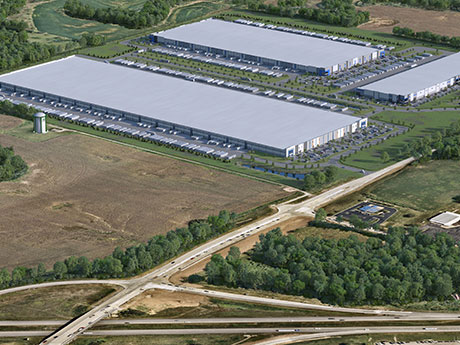By Scott Bluhm, Newmark Zimmer
Since 2016, the Kansas City industrial market has been on a hot streak. We observed more opportunities and increased user activity. There have been consistent years of record positive space absorption and the delivery of Class A buildings, whether speculative or build-to-suit.
The peak of that hot streak was in 2022. The year concluded with records in positive absorption, vacancy and rental growth. By the end of 2022, Kansas City became the 15th-largest industrial market in terms of square footage, surpassing Seattle.

Significant statistics for 2022:
•Over 16 million square feet of positive absorption
•A vacancy low of 3.6 percent
•A 10.6 percent increase in rental rates
The year 2023 has been unique due to economic conditions and uncertainty. New speculative construction starts are down approximately 70 percent, with around 2.5 million square feet breaking ground in 2023. Most of the speculative buildings delivering in 2023 were projects that began construction in 2022.
Annual net absorption has decreased to 2.5 million square feet in the first and second quarters. For reference, the fourth quarter of 2022 saw a record-setting net absorption of approximately 7.3 million square feet, and the third quarter of 2022 had 3.2 million square feet.
Why?
•Cost of construction: Construction prices have started to plateau, and in some trades, they are declining, but they remain 40 percent higher than pre-pandemic levels. Labor availability, especially skilled labor, is a common theme and topic in Kansas City and other markets. While roofing and steel have seen decreased lead times, electrical components like switchgear and meters still have a six- to 12-month wait.
•Cost of capital: Rising interest rates lead to higher debt service for construction loans, narrowing profitability margins. Higher rental rates and annual increases attempt to offset this, but can’t keep up with constant interest rate hikes. This also affects tenants and correlates back to the cost of construction.
Tenant improvement allowances provided by developers continue to rise but are still unable to cover the majority of tenants’ costs to build out a space. In today’s environment, it may cost up to $160+ per square foot to build out office space in a newly constructed shell building, a number that is 50+ percent higher than three to four years prior. Lastly, and perhaps most importantly, is the expectation or prediction of where the asset will sell in the market.
•Availability of good land sites: To the untrained eye, there are vast amounts of “green” and vacant land to the north, east, south and west of downtown. However, most of these sites have significant obstacles to development, with infrastructure being probably the most important and costly.
The availability or cost of sewers is commonly the largest obstacle, but other utilities such as gas, water and power can also have additional impacts. The cost to extend or bring these utilities to sites can be exorbitant and impossible to overcome. Other obstacles include the city’s master plans for lighter uses (residential, multifamily and retail), recent Supreme Court rulings impacting the USACE’s wetlands policy and roads/access.
Looking ahead
This is by no means meant to be a pessimistic view of the industrial and speculative market in 2023. I am often criticized for being an optimist, but I believe people appreciate being around an optimist, especially in uncertain times. However, it’s still important to be realistic. With that said, there are many key indicators that the Kansas City industrial market has remained strong and will likely see future success like in prior years.
Tenant demand
Our Newmark Zimmer Industrial and Logistics Team is currently tracking just under 20 million square feet in tenant demand, with early activity in the third quarter picking up. This statistic only tracks users looking for 40,000+ square feet. Some of those tenants may choose to renew, explore other markets or simply take no action, but it still represents real companies evaluating their space needs. Activity with smaller users continues to be steady, with those size users continuously growing or seeking new spaces. Our Class B and C products have also benefited from recent market success and growth, experiencing significant rental growth and low vacancy rates.
Cost of occupancy
Kansas City performs well compared with other peer markets due to its cost of occupancy. While construction costs are similar in most markets, specific variables like land prices, tax abatements and rental rates result in savings for end users.
Geographic strength
Kansas City is located in the center of the United States and is the only major metro that can reach 85 percent of the country’s population within a one- to two-day truck drive. There are five Class 1 rail lines that pass through Kansas City (now four with the CPKC merger), and there are four intermodal parks. Additionally, four major U.S. highways intersect in Kansas City. According to the Brookings Institution, Kansas City is the No. 2 auto hub for manufacturing and assembly.
What does this mean?
Kansas City will likely remain a robust and insulated industrial market even during times of economic uncertainty. While not impervious or unaffected, Kansas City will not experience the lows that other peer markets will.
Scott Bluhm is a managing director and principal with Newmark Zimmer. This article originally appeared in the September 2023 issue of Heartland Real Estate Business magazine.


